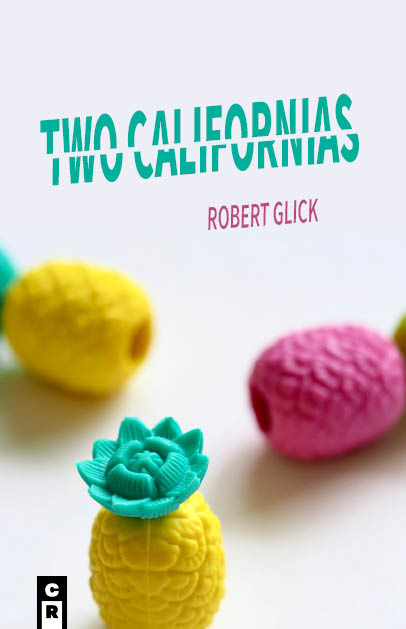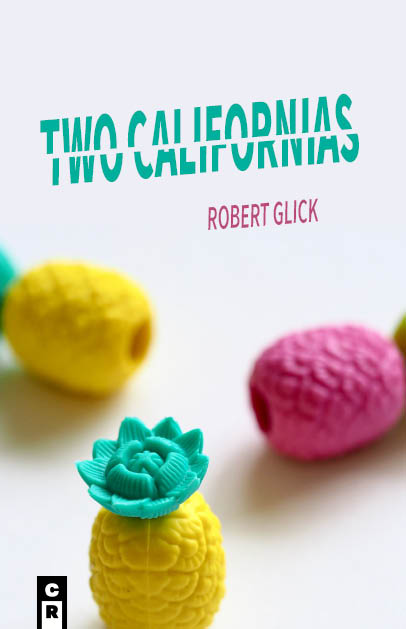
There are nuggets of gold sprinkled throughout Robert Glick’s debut story collection Two Californias. The characters in these stories traverse the length of California’s North-South stretch of landscape in a way that feels both intimate and transitory: teenagers working in a pharmacy in the San Gabriel Valley, a Cal graduate student traveling to Topanga Hills to make a final visit to his dying grandmother, a Dutch transplant traversing Ocean Beach with a newfound friend. California is brought to life in the details of these stories, details that are scattered throughout like delicate flakes of gilt, indicative of Glick’s strongest attribute, a crisp precision of language. This California is delivered to us as a mashup of Allen Ginsberg’s beard, picking slugs off organic crops by moonlight, MacArthur BART, mass Ritalin theft, Gaia Organic Blend coffee, and the peripheral existence of Las Vegas and it’s “many megajoules of light.” These details, alongside the permanent aura of transition that coats every sentence, howl to us native Californians, a recognition of our shared occupancy.
A hallmark of California writing is the ability to find authoritative standing via the refusal of authority, to bleed hope from a terrain of nihilism. This is something that Glick undoubtedly gets right. As we accompany the unnamed male narrator with a zombie fetish to his grandmother’s death bed in “Release,” we receive acknowledgement of this paradox:
[People who visit Auschwitz] feel warm sun on their skin, daffodil fluff floating pacific around them, and they interpret their discomfort as survivor’s guilt. There should really be a movie about Holocaust victims who return as zombies to wreak revenge on the Reich.
This protagonist returns several stories later, as he’s getting ready to put his zombie studies to rest. Though, the extended metaphor of his zombie infatuation seems overwrought and cliché, it points to an ease with death that many of Glick’s characters possess. “She looks so shrunken and animal now,” the narrator describes his grandmother on her deathbed. “Each shallow exhale bubbles like a percolator. I reach the edge of the bed, slide my hand under her chalky fingertips. Already she’s crumbling to dust.” The heartbeat of the collection thrums in these moments in which Glick’s characters find themselves standing at the edge of decrepitude, sometimes running from this, sometimes circling it, sometimes facing it head on. The author refuses to shield his audience from these brutal truths of the body, and Glick somehow finds vivacity in the cold subject matter of death, allowing this tension to propel us forward through the collection.
This is especially true in the final story, “Failure Mechanism (Voicebox).” In this story, protagonist Bean becomes involved in running the first needle exchange center in North Oakland. Their first client, John who is wheelchair bound and wearing a Public Enemy shirt, approaches their roving baby buggy full of clean, unused needles to make an exchange. Bean and his accomplice Callie quickly discover that expecting clients to stick to safety protocol’s might be too much to ask:
“I have dirty needles,” John typed.
Callie looked in his side bag; the points were loose and uncapped, which went against every protocol they had drawn up. For safety, the client had to cap the points as well as place the points into the Sharps, and ideally the points would be rubber banded in groups of ten or twenty.
Bean lifted the bottom of John’s bag, dumping the needles onto the typing pad.
“First client ever!” he replied. He took a broken branch and prodded the dirty needles forward from the typing pad onto the ground. He took the Sharps from the buggy and set it next to him. Then he kneeled, counting each needle as he carefully dropped it into the Sharps.
Bean’s story is rendered beautifully in poetically styled vignettes, each with their own heading and assembled into a chaotic, time-fluid examination of how young people reckon with loss. The characters in this story are sharpened in our imaginations by their relationship to death—Bean meandering through possibility, forever liminal, hating “the martial vocabulary of illness;” Trish issuing guiding commandments to breathe and accept ; Cynthia harboring the close belief that death is just another form of travel; and Callie pragmatically dismissing the transmission of emotional pain between humans. The characters are so precise in their individual approaches towards the world that they feel sometimes like rogue planet moons, drifting in orbit around Bean and very nearly colliding, unified only in their pull towards “the art of breaking down.” And in their collective hope.
Glick’s rendering of the many manifestations of death is offset with this hope. Hope, is the elephant pendant in the room, the one Jacob tries to acquire as a Mother’s Day present in the opening story, “In the Room / Memory Is / White”:
He could see his mom putting on the necklace. He could see the halo of a kiss on his forehead. The elephant’s watching emerald eye, wise. She would, at that moment, have forgiven him for the television—without even knowing he had broken it.
Jacob is barely able to obtain the pendant, even with all the money he has saved to buy his “make-your-own-radio.” He can afford this small gift, but the circumstances of his purchase spiral out of his control and he ends up stealing it instead. This first story in the collection ends in a final gasp as Jacob runs from the store clerk, pendant in hand, after being surprised by his mother’s presence. She has arrived to pick up food for dinner after undergoing an abortion. A young Jacob is kept in the dark about his parents’ problems. Family and gender politics, as well as the burden of womanhood during the 80s, the decade the story is set in, feels familiarly uncomfortable in this story. It is accurate yet opaque in its depiction of marital fighting and infidelity. Jacob often finds refuge from the arguments in the backyard hot tub:
Four dead wasps floated in the water—how did they get there? … Then the cover lifted up and sunlight streamed in, making the water oily bright like soap bubbles, and his Mom was standing over him.
He lifted his arms a little out of the water, as if offering it to her. She was going to pull him out and spank him. Even though Coke had been declared off-limits, he had taken a glass, left it on the table. Sorry, he whined.
She kneeled. Dead wasps scattered in slow wave across the water. Can I come in? she asked. Clothes and all, she got in and tugged the cover over them.
In these quiet scenes of cumbersome intimacy is where Glick charms us. And yet, Jacob’s mother, Mrs. Mulhouse, is never presented to us as a fully rendered character. Her private moments are few and far between and when she is granted these scenes of interiority, they are imposed upon by her obligations as wife and mother. Her husband, on the other hand, is granted moments in parking garages and with his mistress Irene, in which he seems to be searching for himself with little regard to his wife or son. But Mrs. Mulhouse is a mother, and thus, a worrier. A woman bogged down by the marital constraints she has found herself in, and with no inkling as to what will make her happy—besides not having another child by her philandering husband and finding all the right ingredients for dinner, of course.
Here is where Glick’s limitations become apparent: his portrayal of female characters frequently falls short of rendering them as full flesh, rife with their own desires outside of the men associated with them. Because of this, they often come across flat and unremarkable. In “Goat Pharmacy,” a teenage Ginny, the protagonist’s best friend’s girlfriend, is little more than a snarky temptress. Rebellious Lena, the primary character of “Mermaid Anatomy” is something of an enigmatic anarchist who seems more performance than person.
Maybe this is just another way that Glick pays tribute to the literary giants that previously reigned over California. After all, Camilla Lopez, the love interest of John Fante’s Los Angeles-based novel Ask the Dust, barely existed as more than a caricature of promiscuity and addiction. An undiscerning sweet spot for the roaming, sensitive California boy whose romantic intensity overshadows any real understanding of women is just another hallmark of classic California literature. In this way, Two Californias solidifies itself as a suitable member of this club.
Two Californias, by Robert Glick. C&R Press, November 2019. 195 pages. $18.00, paper.
Feliz Moreno earned her MFA in Creative Writing at the University of San Francisco. She is working on a book about a young, Mexican-American woman who became the first felon of Orange County in 1889 after protesting against the railroad. Her work has appeared in The Acentos Review, Longreads, Apogee, Vestal Review, and Watermelanin Magazine. She is the Managing Editor of the VIDA Review and currently lives in Oakland, California.
Check out HFR’s book catalog, publicity list, submission manager, and buy merch from our Spring store. Follow us on Instagram and YouTube. Disclosure: HFR is an affiliate of Bookshop.org and we will earn a commission if you click through and make a purchase. Sales from Bookshop.org help support independent bookstores and small presses.


Leave a comment